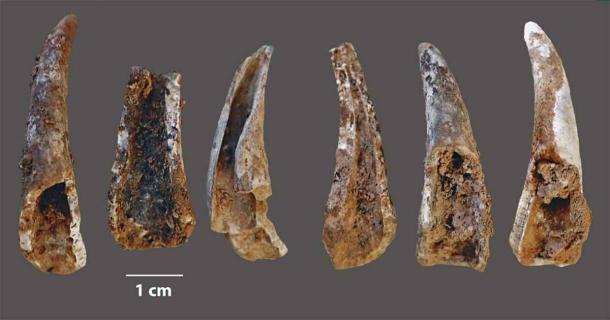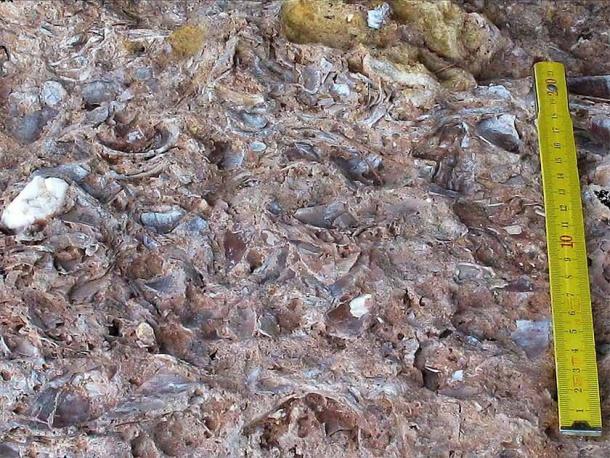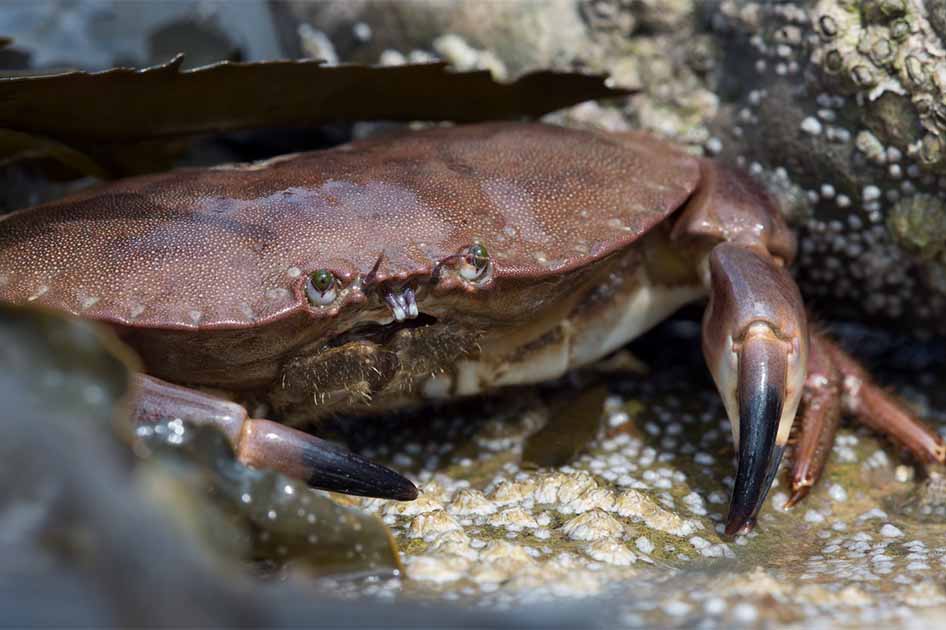Proof Emerges that Neanderthals Harvested and Ate Crabs 90,000 Years Ago
New research has once again illustrated that the Neanderthals were neither primitive nor unsophisticated. It shows that Neanderthals living in a cave near Lisbon, Portugal 90,000 years ago enjoyed a rich and diverse diet that included healthy amounts of crab meat. Crab is recognized as a delicacy even in the modern world, that takes hard work and advanced knowledge to obtain in abundance. Well, it seems this is what the Neanderthals were doing 35,000 years before the first modern humans even arrived in Europe.

Entrance to Gruta de Figueira Brava, south of Lisbon, where the evidence of crab eating has been found. (Public Domain)
Crab Delicacy Became A Staple For These Neanderthals
In Gruta de Figueira Brava, a seaside cave just south of Lisbon along Portugal’s Atlantic coast, archaeological digs have produced ample remains that reveal the specifics of the ancient Neanderthal diet.
A study just published in the journal Frontiers in Environmental Archaeology reports that, in addition to the charcoal remains of past cooking fires, excavators unearthed deep and rich deposits of shells and bones that come from the animals the Neanderthals consumed. Among the most notable of these organic remains were crab shells, which were found in quantities to show this tasty crustacean was a staple of the cave dwellers’ diet.
- Neanderthal Child Development Was Faster than Humans
- Did The Neanderthals of Shanidar Cave Really Bury their Dead?
"At the end of the Last Interglacial, Neanderthals regularly harvested large brown crabs," said study lead author Dr. Mariana Nabais of the Catalan Institute of Human Paleoecology and Social Evolution in Tarragona, Spain, in a Frontiers press release.
"They were taking them in pools on the nearby rocky coast, targeting adult animals with an average carapace width of 16cm (6.3 inches). The animals were brought whole to the cave, where they were roasted on coals and then eaten."
In other words, Neanderthal chefs who lived during the last 100,000 years or so of the Paleolithic or Old Stone Age were demonstrating cooking skills that wouldn’t seem out of place in the modern age. They were preparing ancient versions of gourmet meals featuring helpings of delicious crab meat, cooked and served to deliver a maximum taste experience.
Dissecting the Leftovers at Gruta da Figueira Brava
What was discovered in the cave in Portugal represents a breakthrough in understanding about Neanderthal culture on the Iberian Peninsula in the time before this legendary hominin came into contact with Modern Humans.
“The marine crustacean assemblage recovered from Gruta da Figueira Brava is the first known from the Middle Paleolithic,” the study authors wrote in their Frontiers in Environmental Archaeology article, acknowledging both the uniqueness and importance of this find.
The crustacean shells were unearthed by teams of archaeologists who performed excavations in the cave between 2010 and 2013. Those researchers found remains from a broad range of shellfish species, but the carapaces of a type of brown crab known as Cancer Pagurus were by far the most common specimen in the deposit.
- 80,000 Years Ago Neanderthals Supercharged Their Brains On Acid
- The Many Ways Cancer Was Treated in the Ancient World

Cracked-open and burnt fragments of pincers of the edible crab (cancer pagurus) found at the Figueira Brava cave, showing evidence of the Neanderthals’ seafood diet. (João Zilhão / University of Barcelona )
In their new study of this collection, Nabais and her team members estimated the size of the crabs’ outer shells or carapaces by looking at their pincers, the latter of which are quite thick and therefore slower to decay and crumble over time than the thinner outer shells. The researchers also checked the shells closely to analyze breakage patterns, as they were specifically looking for indications that the shells had been cut or cracked open by humans. Through an analysis of the condition of the various shell pieces they were also able to tell whether they had been exposed to high heat in a roaring fire.
Making logical inferences based on the evidence, the scientists determined that the preserved crab shells came from mostly large adults, each of which would have produced approximately 200 grams of crab meat. The damage done to the shells was not caused by carnivores, birds or rodents, the researchers also found, meaning they’d been cut or broken open by human hands. This could have been done by smashing them on rocks, or perhaps by using some of the stone tools that were found in Gruta de Figueira Brava in the same excavation level that contained the crustacean shells.

View of mussel fossil bed found at Figueira Brava excavation site, showing evidence of the Neanderthals’ seafood diet. (João Zilhão / University of Göttingen)
The patterns of the shell fractures suggested they’d been broken open exclusively to access the meat inside. About eight percent of the shell fragments studies had burn marks, which showed the crabs were being roasted on a fire before being broken open.
In 90,000 BC, Europe’s Finest Chefs were Neanderthals
Taken all together, the evidence shows that the Neanderthals who lived at Gruta de Figueira Brava in the Middle Paleolithic were experts at harvesting and preparing crabs and other seafood for consumption. While crabs can be difficult to catch, they are easier to capture when trapped in low tide pools, as they would have been during the summertime along the coast of Portugal 90,000 years ago.
By studying the characteristics of the shell burn marks, Nabais and her co-authors, archaeologists João Zilhão from the University of Lisbon and Catherine Dupont from the University of Rennes in France, determined that the crabs had been heated to about 550-900 degrees Fahrenheit or 300-500 degrees Celsius. This is much hotter than a modern stove and cooler than many open fires, but ideal for cooking crab meat quickly and thoroughly while preserving its moisture and tenderness.
"Our results add an extra nail to the coffin of the obsolete notion that Neanderthals were primitive cave dwellers who could barely scrape a living off scavenged big-game carcasses," Nabais declared. "Together with the associated evidence for the large-scale consumption of limpets, mussels, clams, and a range of fish, our data falsify the notion that marine foods played a major role in the emergence of putatively superior cognitive abilities among early modern human populations of sub-Saharan Africa."
In other words, if a species was catching and cooking shellfish and other marine animals, it showed a relatively high level of intellectual and cultural advancement. Early modern humans were doing this, but Neanderthals were doing it too, at least in one area of the Iberian Peninsula along the Atlantic coast.
"The notion of the Neanderthals as top-level carnivores living off large herbivores of the steppe-tundra is extremely biased," said Nabais. "Such views may well apply to some extent to the Neanderthal populations of Ice Age Europe's periglacial belt, but not to those living in the southern peninsulas—and these southern peninsulas are where most of the continent's humans lived all through the Paleolithic, before, during and after the Neanderthals."
Overall, what the evidence reveals is that Neanderthal populations were flexible and opportunistic, altering their dietary preferences and eating practices to suit the local ecology. When crabs were available in abundance, they adjusted their nutritional strategies accordingly.
Top image: Neanderthals were eating brown crabs like this 90,000 years ago. Source: davemhuntphoto/Adobe Stock
By Nathan Falde




















Comments
So much for Neanderthals being unable to adapt, as many alive today seem to think. Ironically, quite a few of rhe latter have no cooking skills whatsoever.